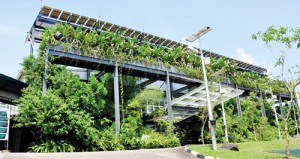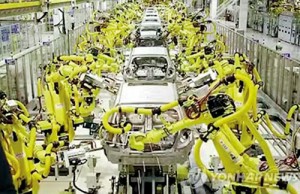Fewer people, more machines – what’s the “Factory of the Future” going to be?
AGALAWATTE – On both sides of a road to a green-covered building, are a pond, a garden being prepared to help a few employees maintain cows saved from slaughter, plants of different varieties and forest cover at the back.
As the car stops nears the factory cum office entrance, passion fruits at pickable length hang from a steel frame. For, a generation like mine growing up in the 1960s and the 1970s, it was like picking fruits from home gardens or reminiscent of an era climbing the, then abundance of trees in a different time space. Yes, it’s a nice feeling as Anil Hirdaramani, Director at the Hirdaramani Group, and I sit down to discuss the ‘factory of the future’.
There is a quirk of fate here. Is this the factory of the future with a hark back to the old days of green, less concrete jungle, healthy living, spacious gardens with medicinal herbs growing so wild that its unnoticeable, workers relaxed and using their spare time to take a quick call (however on a modern contraption – mobile phones) rather than spending a 30-minute break eating or drinking, using available light for manufacture during the day in a system that automatically switches off generated power and comes on (in an effective power saving mechanism) when the light fades outside or a thick cloud covers the sun?
It was about 2-3 months ago during a conversation with Anil at a Colombo social gathering to welcome a top Asian hotelier that both of us discussed the future of Sri Lanka, the work space, labour and whether large industries will survive with large workforces against rapid technology, mechanization, robots and the kind.
Then we got talking about the factory of the future (and how an environment of more machines and less human involvement would evolve).
That’s how we ended up driving to the Hirdaramani Group’s landmark green garments’ facility ‘Mihila’ (means earth) at Agalawatte, 70 km south of Colombo with easy access on the Southern Highway.
“Let’s have a discussion at our green factory,” Anil had suggested during that earlier conversation.
If the overhanging fruits were indeed a pleasant welcome, the wide open spaces on the factory floor with high roofs and glass panels to allow enough natural light into the production facility plus melodious Sinhala songs and music wafting through speakers, gave a lot of food for thought on one of the ways of merging machines and humans with the environment with the least amount of destruction to the latter.
At the factory auditorium, Mihila General Manager, Chamara De Silva, switches on the air conditioning, saying “its kept off at all times to conserve energy”, and then proceeds to explain the factory concept through a comprehensive video presentation. Outside leaves and branches rustle as the wind blows while on the mountainside in the distance, a patch of brown earth amidst trees is very noticeable. “There was a forest fire and we called for support from the fire brigade but it was too late. How it started no one knows,” he said adding that they were visibly upset over  the loss of a valuable green patch.
the loss of a valuable green patch.
The Mihila factory, launched in 2008, has won many green and sustainable awards and widely written about in local and international media. However once in a while it’s important to revisit such innovative and sustainable ventures that, though a drop in the ocean, help to keep Earth away from a path of destruction.
Chamara takes us through the entire production facility and its add-ons – the process of energy conservation, renewable energy, water conservation and waste management.
The factory consumes 48 per cent less energy than a conventional facility, has sky lights that help brighten up the factory floor eliminating the need to switch on power-generated lights, white roofing sheets provide a cooling effect, solar street lights and solar power generation.
It has an Arboretum (collection of trees) forest, and vegetable and herbal gardens. As we walk through the factory space, workers are busy on the nicely, spaced-out main floor preparing garments of all kinds including some woolen stuff. Lines on the floor demarcate teams that are involved in different aspects of work with motivation provided through an awards scheme. A health clinic has a trained, permanent nurse while a doctor visits regularly. An in-house shop sells all the food stuff required by a household at cheaper wholesale prices with payment deducted from a worker’s monthly wage. In the gardens, some workers are seen using talking on mobile phones.
“This is their break and they limit the ‘food’ time to take calls,” says Chamara.
Yet at the end of the conversation were unanswered questions as to how does one tackle job losses, reduce labour or when smaller companies or SMEs demand more work from people to keep up with robotic-based competition? What would be the role of trade and manufacturing unions? These are the challenges. Only time will tell whether industry in the world will be a fully automated machine or still have human hands helping its progress.
| Future of the factory Like many of the sons of pioneers of Sri Lanka’s garments’ trade in the 1950-1960s, Anil Hirdaramani’s generation is looking at taking garments to the next level of modernisation, techno-driven and examining whether it would be as labour-intensive as it is today. Here are his thoughts: n The garment industry has historically shifted towards the cheapest needle. 1) Consider ‘Fast Fashion’ where the consumer is demanding instant gratification which led to the success of Zara. This company is a Spanish clothing and accessories retailer based in Arteixo, Galicia and is said to be the world’s fastest fashion retailer, capable of developing a new product in one week and getting it into its stores, compared to the six-month industry average. Even supermarkets are in this space with Asda, George Brand, Tesco and Sainsbury as examples. The garments industry is still labour intensive as mass production still dominates the arena. Perhaps the next step is mass customization as in the auto industry. Technology will play a huge role in changing the way apparel is produced in the future. Robotics – With the necessity to de-skill operations we will see an increase in this area. Bonding and Seam sealing – These are alternates to sewing especially for performance fabrics and for apparel in the industrial and medical fields. The consumer is demanding clothing faster, better and cheaper. As electronics get cheaper and pressure on pricing continues, the way forward is to do more with less. How soon (this would happen) is anybody’s guess but taking a page from the microchip sector it may be sooner than later. Robots help smarter production At a US-based Kiva Systems’ robotic warehouse, orange robots instead of workers make inventory move. Over time the system becomes increasingly efficient, with the robots learning from the wisdom of the crowd, according to a video – http://www.sundaytimes.lk/150712/  Screen grab from a video
The warehouse was set up Massachusetts, US by Kiva to demonstrate the system. Here engineers can place six to eight orders at a time and the robots bring them the inventory. Engineers or workers need not walk around the warehouse. Robots bring the order, and accurately. “Imagine a world where we can 3D print a full-size cargo plane or quickly produce a body part to save someone’s life. Through additive manufacturing or 3D printing, we are bringing people closer to products and solving challenges in new ways. We are pushing the limits of this technology to produce parts quick,” says a video by aircraft manufacturer Lockheed-Martin (See http://www.sundaytimes.lk/150712/ Another video titled “The Future of Factory Automation – https://www.youtube.com/watch?v=wZkZb9I-g3s” describes how since the 1970 factories have become ever more automated. It discusses current trends in factory automation and shows how networked facilities are changing the landscape of manufacturing where manufacture has become smarter Amazon, which dealt with only books earlier, is now the biggest online retailer dealing with anything sellable. But working conditions at its UK warehouses where it, according to a BBC report in 2013, were reportedly ‘horrible’. A BBC November 2013 report said, “It’s the online retailer that has transformed the way we shop, but how does Amazon treat the workers who retrieve our orders? Working conditions in the company’s giant warehouses have been condemned by unions as among the worst in Britain”. Then more than a year later by January 2015, Amazon had deployed 15,000 of these robots in US warehouses. Will this be the factory or warehouse of the future?
|


